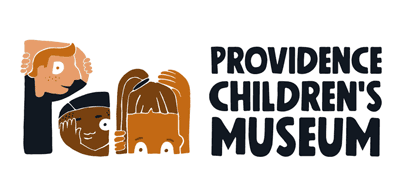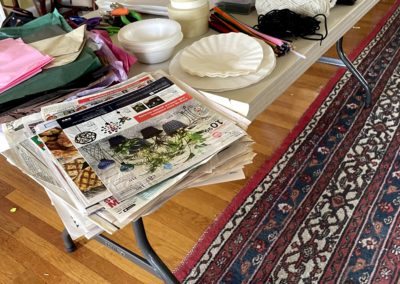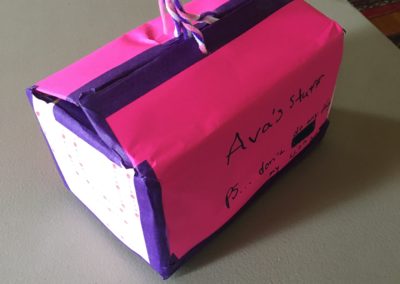Reduce, Reuse, Recycle, & Recreate!
Developed by Lauren Angel, PCM Play Intensive 2021
(FOCUS: STEAM, Creativity & Making, Design Thinking-Engineering Design Process, History & Humanities)
Downloadable PDF
Understanding the role we can all play in taking care of the earth is important. Prompt students to think creatively by reusing materials that will be thrown out or recycled. Students will transform materials, develop problem solving skills and be able to explain what they created and how it can be reused in a different way.
To kick off the week, teachers are encouraged to activate Prior Knowledge by reviewing the vocabulary words, Reduce, Reuse, & Recycle. This will encourage discussion and schema activation. Teachers will record their student’s thoughts on chart paper/in a digital way to look back at as the week/lesson continues.
Suggestions for Read alouds to assist with activation of prior knowledge: The Adventures of a Plastic Bottle by Alison Inches & Earth Ninja by Mary Nhin.
By the end of the week students will be able to create something new from materials that have been collected by themselves and their peers. Then, students will be able to explain what they created and why it will be useful to them.
This project will help students to understand the role that we have in taking care of the earth while also allowing students to develop problem solving skills and creativity.
MATERIALS
- Books to read aloud to activate prior knowledge. Whether they be the suggested books (above) or other books that discuss the 3Rs (reduce, reuse, recycle).
- Bins to collect trash and other materials in throughout the week. 4 different bins for paper, plastic, glass/metal, and any miscellaneous materials.
- Chart Paper/Poster board
- Crayons, markers, or other writing utensils for making the poster board.
- Tape
- Staplers
- Glue
- Paper clips
- Trash/recyclables throughout the week - these can include rinsed out plastic bottles, cans, milk cartons, snack wrappers, tissue boxes, paper scraps, unused art supplies from projects, etc.
Set Up:
The teacher will provide the bins for material collection. The class will work together to create posters for each of the bins that will be left up so that students can recall the proper way to dispose of their materials throughout the week.
Student’s Job
We are going to spend one week collecting recyclables that would normally be tossed out. Then we will create new uses for the materials which should keep them from the landfill.
- Listen and participate in conversations around the read alouds and videos in order to activate prior knowledge.
- Describe what it means to reduce, reuse, and recycle and how this helps our earth. Work together to create posters for materials that will be collected throughout the week.
- Collect materials from snack time/lunch time/etc. throughout the week in the appropriate bin
- Make a plan for something that they can create from recycled/collected materials. First, look at all of the materials that have been collected throughout the week to take a “mental inventory”. Then, think about their plan. Next, verbally discuss their plan with a partner to receive feedback. Next, sketch out their plan on paper and label the different parts. Finally, verbally share their ideas with their teacher so that support can be offered if needed. (the planning session could be one class period and creating can take place on another day if needed).
- Use the collected materials to create based on their plan.
- Share their creation and explain why they made it and how it will can be useful to them or to others.
Further Challenges:
Students should plan out what their design will look like- can use the Engineering Design Process to get them started on how to plan. If not all materials have been used, students can be grouped together to create something more.
Teacher’s Job
Standards Alignment
RI GSES (GRADE SPAN EXPECTATIONS)
SOCIAL STUDIES: CIVICS & GOVERNMENT 5 (K-2)-3
Students demonstrate an understanding of how the choices we make impact, and are impacted by an interconnected world, by…listing the pros and cons of personal decisions (e.g., littering, recycling)
SOCIAL STUDIES: GEOGRAPHY 4 (K-2) –3
Students explain how human actions modify the physical environment by…discussing the impact reducing, reusing, and recycling can have on the earth.
COMMON CORE STATE STANDARDS.ELA-LITERACY.SL.K.1.A
Follow agreed-upon rules for discussions (e.g., listening to others and taking turns speaking about the topics and texts under discussion).
COMMON CORE STATE STANDARDS. ELA-LITERACY.SL.K.1.B
Continue a conversation through multiple exchanges.
COMMON CORE STATE STANDARDS.ELA-LITERACY.SL.K.6
Speak audibly and express thoughts, feelings, and ideas clearly.
Connections to previous work?
Engage NY Taking Care of the Earth Unit- Throughout this unit, students will be learning about different ways that they can care for the Earth. Then, they will be able to participate in this culminating activity to demonstrate their knowledge of what they have learned.
Prepare/ Background Info
- Get the Read Alouds and plan out questions that will foster rich conversations.
- Gauge Student’s prior knowledge through the first discussion and plan more activities (read alouds, discussions, videos, etc.) if needed.
- Read the books and show the videos.
- Review the Engineering Design Process prior to allowing the students to begin their planning process. Discuss the steps of designing something useful.
- Set up the bins to collect materials (find a good space in the classroom) and facilitate a poster making session for each- giving some examples of what might be placed in each bin.
Effective Facilitation:
Question students to grasp their understanding of the vocabulary words. Have students complete the exit ticket (attached) in order to demonstrate understanding.
Supervise students as they plan and create using a hand in pocket approach.
Set up a sharing schedule for students to share their creations. Throughout the creation process, look at the student’s designs and try to schedule similar creations to be shared around the same time so that connections can be drawed between some.
During the sharing time, use guiding questions/prompting to help students explain effectively with great detail.
Suggested guiding questions/prompts
- What materials did you use and why did you choose those?
- Who can use this creation/who would this be useful for and why?
- Can you use this creation more than once?
- How did you feel while planning and then creating? Did you have to change things as you went along?
- Does this creation remind you of someone else’s? How so?
- Is there anything that you wish you did differently?
Play to Notice:
Hands in pocket approach-use voice instead to ask clarifying questions around the problem-solving processes that students are experiencing as they create.
Observe and take notes of what the teacher notices while walking around and watching students create to then use during their presentation times- this may help the teacher use the guided questioning approach more effectively if they have some sort of understanding of the student’s though processes ahead of the share time.
Content Matter to Notice:
Use the exit ticket to notice which students understand the vocabulary and the purpose for the activity. Reteach to a group of students if necessary.
During sharing time, note student’s ability to explain why they used the materials they did and if they include any information about why they think their creation will help the earth. Note how much prompting/support was needed.
Speaking and Listening standards-listen and record ability to speak audibly to convey their thoughts and information.
SEL to Notice:
Ability to problem solve as students take materials and someone else may take something they planned on using. Ability to share and use their words to express how they are feeling.
Assessment: How you will know that students met the learning goals that were set out for them.
What to look for?
- Students will be able to use the vocabulary words correctly- mastery on the exit ticket.
- Students will persist if they can’t get the transformation quite right the first time.
- Students are together and building in a social way, do they borrow ideas, make suggestions, etc.
- Students reference their own cultural (family experience) background.
- Students verbally explain their creation with or without prompting.




0 Comments